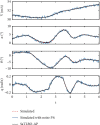Aircraft Control Parameter Estimation Using Self-Adaptive Teaching-Learning-Based Optimization with an Acceptance Probability
- PMID: 34966419
- PMCID: PMC8712132
- DOI: 10.1155/2021/4740995
Aircraft Control Parameter Estimation Using Self-Adaptive Teaching-Learning-Based Optimization with an Acceptance Probability
Abstract
This work presents a metaheuristic (MH) termed, self-adaptive teaching-learning-based optimization, with an acceptance probability for aircraft parameter estimation. An inverse optimization problem is presented for aircraft longitudinal parameter estimation. The problem is posed to find longitudinal aerodynamic parameters by minimising errors between real flight data and those calculated from the dynamic equations. The HANSA-3 aircraft is used for numerical validation. Several established MHs along with the proposed algorithm are used to solve the proposed optimization problem, while their search performance is investigated compared to a conventional output error method (OEM). The results show that the proposed algorithm is the best performer in terms of search convergence and consistency. This work is said to be the baseline for purely applying MHs for aircraft parameter estimation.
Copyright © 2021 Yodsadej Kanokmedhakul et al.
Conflict of interest statement
The authors declare that they have no conflicts of interest.
Figures








Similar articles
-
Chaotic Teaching-Learning-Based Optimization with Lévy Flight for Global Numerical Optimization.Comput Intell Neurosci. 2016;2016:8341275. doi: 10.1155/2016/8341275. Epub 2016 Jan 31. Comput Intell Neurosci. 2016. PMID: 26941785 Free PMC article.
-
Intelligent adaptive nonlinear flight control for a high performance aircraft with neural networks.ISA Trans. 2006 Apr;45(2):225-47. doi: 10.1016/s0019-0578(07)60192-x. ISA Trans. 2006. PMID: 16649568
-
Application of Meta-Heuristic Algorithms for Training Neural Networks and Deep Learning Architectures: A Comprehensive Review.Neural Process Lett. 2022 Oct 31:1-104. doi: 10.1007/s11063-022-11055-6. Online ahead of print. Neural Process Lett. 2022. PMID: 36339645 Free PMC article. Review.
-
A hybrid metaheuristic DE/CS algorithm for UCAV three-dimension path planning.ScientificWorldJournal. 2012;2012:583973. doi: 10.1100/2012/583973. Epub 2012 Oct 21. ScientificWorldJournal. 2012. PMID: 23193383 Free PMC article.
-
A bat algorithm with mutation for UCAV path planning.ScientificWorldJournal. 2012;2012:418946. doi: 10.1100/2012/418946. Epub 2012 Dec 27. ScientificWorldJournal. 2012. PMID: 23365518 Free PMC article.
References
-
- Blake W. Prediction of Fighter Aircraft Dynamic Derivatives Using Digital Datcom . 1985. - DOI
-
- Drela M., Youngren H. Athena vortex lattice (AVL) Computer Software. AVL . 2008;4
-
- Anderson J. D., Wendt J. Computational Fluid Dynamics . Berlin, Germany: Springer; 1995.
-
- Klein V., Morelli E. A. Aircraft System Identification: Theory and Practice . Reston, VA, USA: American Institute of Aeronautics and Astronautics; 2006.
-
- Peyada N. K., Sen A., Ghosh A. K. Aerodynamic characterization of HANSA-3 aircraft using equation error, maximum likelihood and filter error methods. Lecture Notes in Engineering and Computer Science . 2008;2169(No. 1):1902–1907.
MeSH terms
LinkOut - more resources
Full Text Sources

